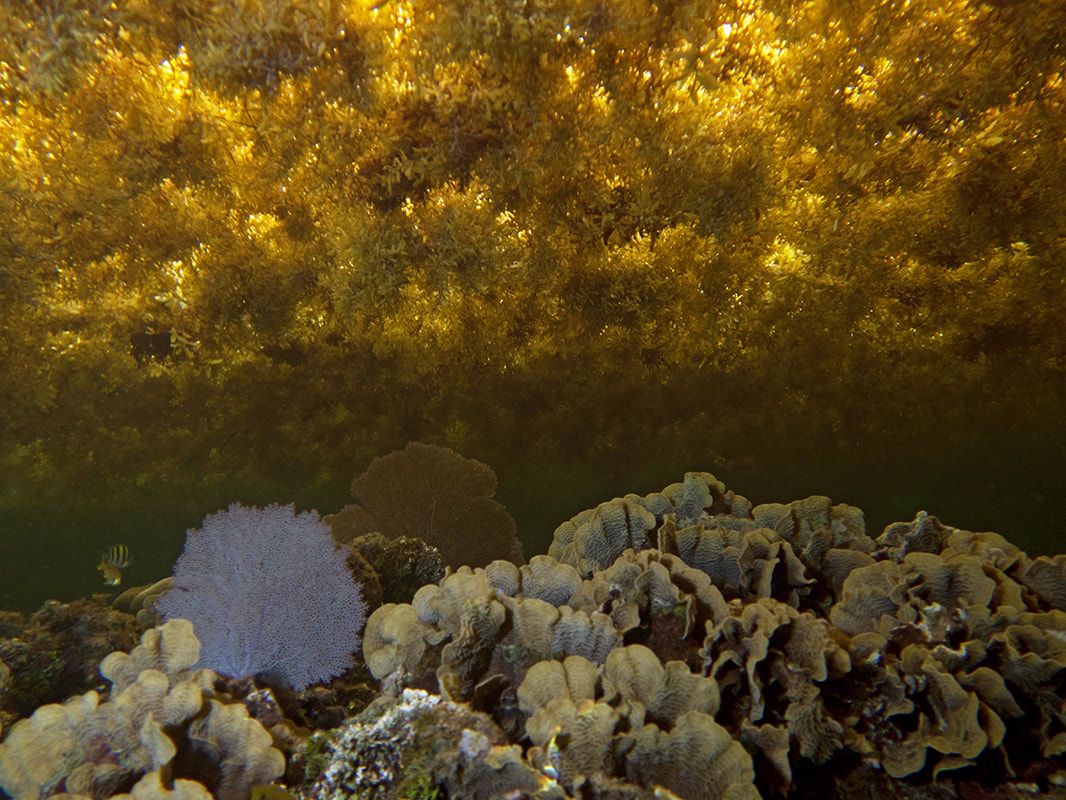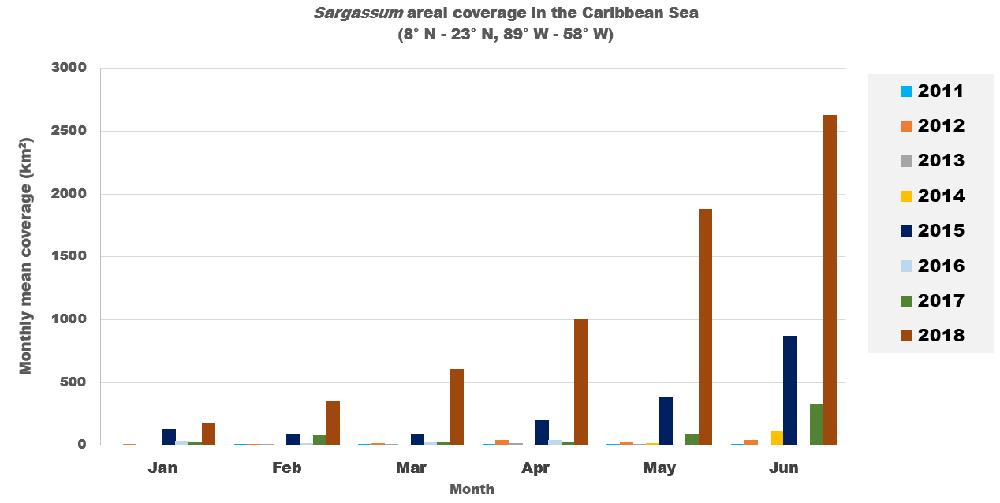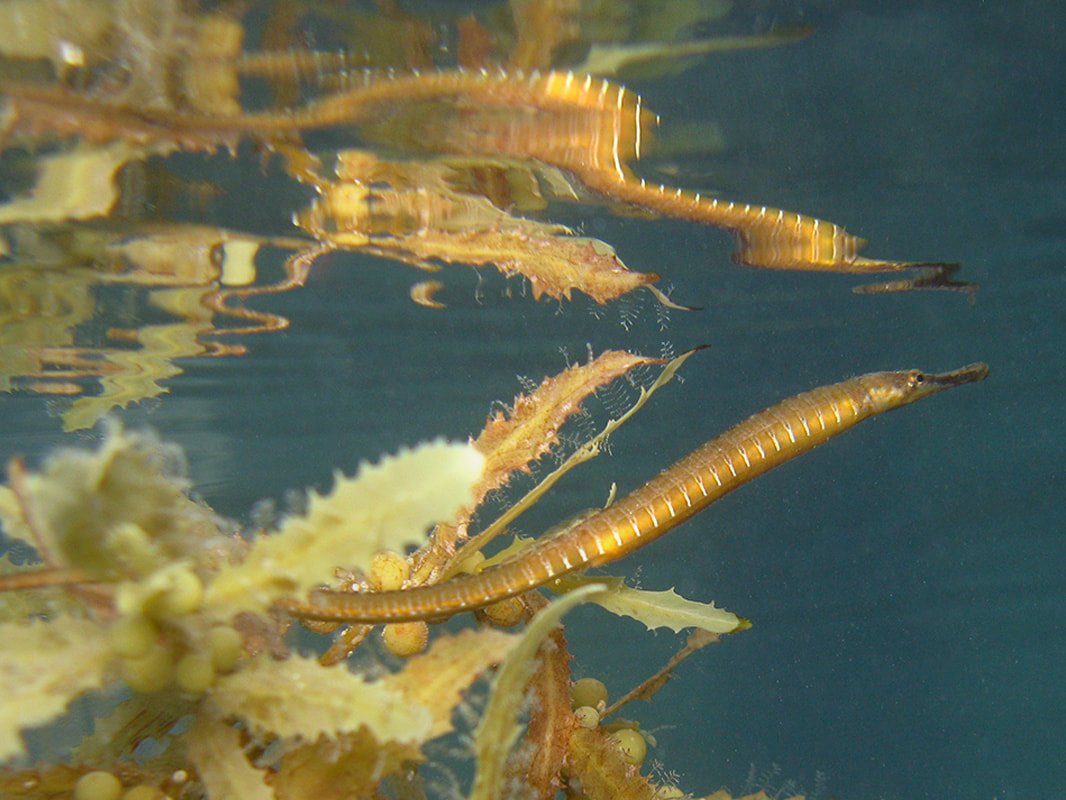Record-breaking amounts of sargassum in the Caribbean: What is it and where is it coming from?1/11/2019 2018 saw the largest sargassum bloom on record, 3 times the previous record. What is sargassum? Sargassum is a unique group of marine plants, brown algae that are kept afloat using small air-filled floats attached to the stalks. Not all sargassum species float on the surface, some remain attached to the reef and the tiny floats help the plant stay closer to the sunlight. The two main floating species are Sargassum natans and Sargassum fluitans. It reproduces by fragmentation and the growing plants can come together to form huge floating mats of brown weed that drift through the Caribbean during the warm summer months. Much of it is blown ashore during our winter storms. In 2011 there was a massive bloom of these plants, and every year since there has been more sargassum than usual in the Caribbean. In the last year we have seen unprecedented amounts of sargassum throughout the region. What's in the Sargassum?
There is a remarkable amount of life that is found living nowhere else. These species have evolved to blend in with the leaves of sargassum, both for protection and as camouflage while they hunt. They will spend their entire lives floating in the brown weeds. The most remarkable resident is the Sargassumfish. This relative of the frogfish has fleshy appendages to help it blend in with the sargassum while it hunts by stealth, and large pectoral fins that allow it to slowly "crawl" through the leaves to find it's next meal. Where is it all coming from? Most sargassum used to originate in the Gulf of Mexico, and would be caught in the normal currents that would take it out into the North Atlantic in an area known as the Sargasso Sea, 700 miles wide and 2000 miles long. This sea is not bound by land, but by ocean currents that form a swirling gyre, keeping the sargassum together. Christopher Columbus apparently thought he had found land when he encountered it on his voyage in 1492. Today it is also a trap for oceanic pollution: there are an estimated 200,000 pieces of trash per square kilometer and it has now been dubbed the "North Atlantic Garbage Patch." But what about the recent sargassum blooms in the Caribbean? After the 2011 bloom, scientists at the University of South Florida Optical Oceanography Laboratory found that this new sargassum had broader leaves than the usual varieties, and have been trying to trace it back to it's source using satelite imagery. For the record-breaking 2018 sargassum bloom they found it was coming from the south, as far away as Brazil, an area that had never before seen such large amounts of sargassum. Research is being done to see if this new strain entering the Caribbean actually represents a new species of sargassum. Fed by warm waters and possibly also the agricultural run-off from the Amazon delta, this new patch of sargassum is taken up by the regular ocean currents that enter the Caribbean from the east. What it means for the Caribbean: Sargassum is a natural, even essential, part of the Caribbean's ecosystems but these recent blooms are having a devastating impact on the region, both ecologically and economically. Many tourist areas and islands were innundated this year. It piles up on beaches, sometimes many feet thick and begins to decay. The hydrogen sulphide that gets released smells like rotting eggs and many resorts had to close their doors. Hydrogen sulphide is dangerous to humans in large quantities, causing headaches, dizziness, nausea and even asthma has been reported in some local communities. It is also extremely corrosive to metals and concrete.
It's not just the tourist industry that will be affected but also the underwater ecosystems that tourism depends upon. The decaying sargassum reduces oxygen levels in the water, causing stress or even death for nearby corals, sponges and fishes. The exact causes of these blooms in the Caribbean are still poorly understood and may involve higher sea temperatures and shifting currents. According to leading researcher Brian LaPointe of Florida Atlantic University: “Our research has found that nitrogen and phosphorus from land-based runoff and pollutants, including nitrogen-heavy fertilizers and sewage waste, are washing into rivers such as the Mississippi and the Amazon. This fuels sargassum growth.”
Whatever the cause, it appears that sargassum blooms are likely to become a common, even annual, event and those of us who live in the Caribbean must be ready to deal with it. It's not going away. Mickey Charteris
24 Comments
|
AuthorMickey Charteris is an author/photographer living on Roatan. His book Caribbean Reef Life first came out in 2012 and is currrently into it's sixth printing as an expanded fourth edition. Archives
August 2019
Categories
All
|














 RSS Feed
RSS Feed